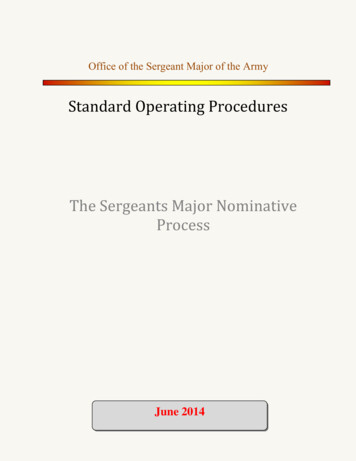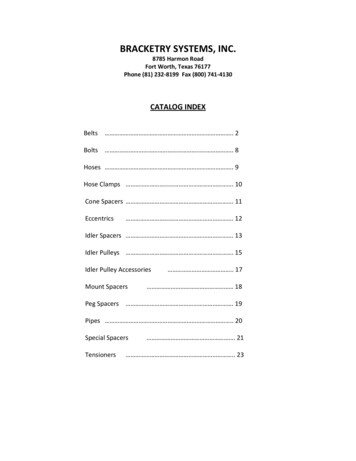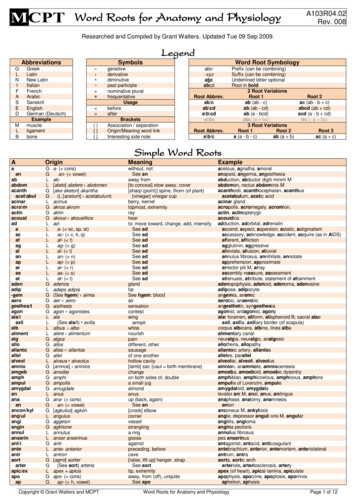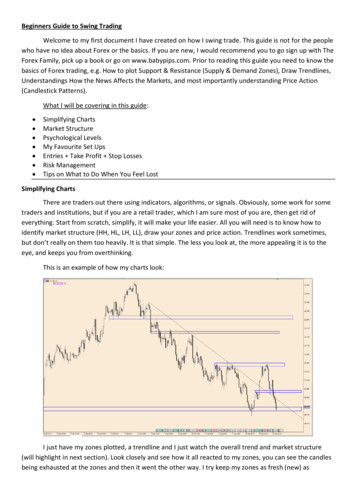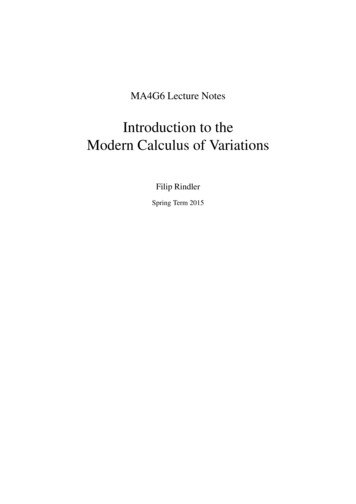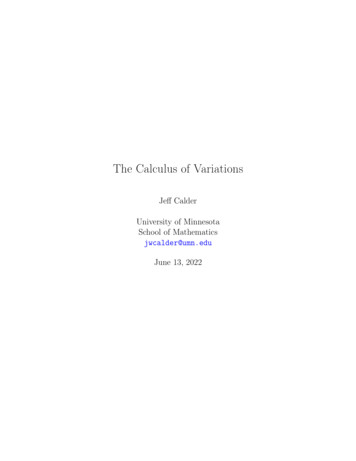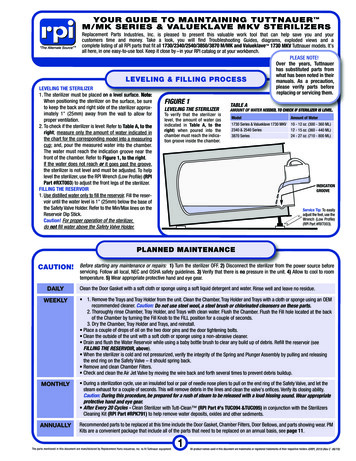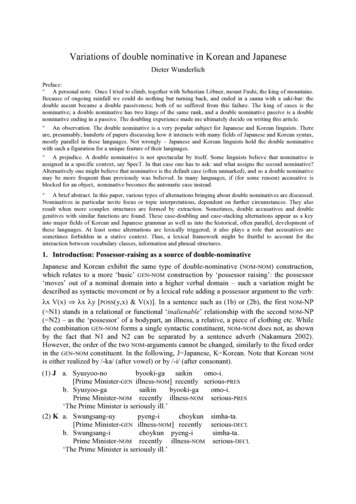
Transcription
Variations of double nominative in Korean and JapaneseDieter WunderlichPreface: A personal note. Once I tried to climb, together with Sebastian Löbner, mount Fushi, the king of mountains.Because of ongoing rainfall we could do nothing but turning back, and ended in a sauna with a saki-bar: thedouble ascent became a double passiveness; both of us suffered from this failure. The king of cases is thenominative; a double nominative has two kings of the same rank, and a double nominative passive is a doublenominative ending in a passive. The doubling experience made me ultimately decide on writing this article. An observation. The double nominative is a very popular subject for Japanese and Korean linguists. Thereare, presumably, hunderts of papers discussing how it interacts with many fields of Japanese and Korean syntax,mostly parallel in these languages. Not wrongly – Japanese and Korean linguists hold the double nominativewith such a figuration for a unique feature of their languages. A prejudice. A double nominative is not spectacular by itself. Some linguists believe that nominative isassigned in a specific context, say SpecT. In that case one has to ask: and what assigns the second nominative?Alternatively one might believe that nominative is the default case (often unmarked), and so a double nominativemay be more frequent than previously was believed. In many languages, if (for some reason) accusative isblocked for an object, nominative becomes the automatic case instead. A brief abstract. In this paper, various types of alternations bringing about double nominatives are discussed.Nominatives in particular invite focus or topic interpretations, dependent on further circumstances. They alsoresult when more complex structures are formed by extraction. Sometimes, double accusatives and doublegenitives with similar functions are found. These case-doubling and case-stacking alternations appear as a keyinto major fields of Korean and Japanese grammar as well as into the historical, often parallel, development ofthese languages. At least some alternations are lexically triggered; it also plays a role that accusatives aresometimes forbidden in a stative context. Thus, a lexical framework might be fruitful to account for theinteraction between vocabulary classes, information and phrasal structures.1. Introduction: Possessor-raising as a source of double-nominativeJapanese and Korean exhibit the same type of double-nominative (NOM-NOM) construction,which relates to a more ‘basic’ GEN-NOM construction by ‘possessor raising’: the possessor‘moves’ out of a nominal domain into a higher verbal domain – such a variation might bedescribed as syntactic movement or by a lexical rule adding a possessor argument to the verb:λx V(x) λx λy [POSS(y,x) & V(x)]. In a sentence such as (1b) or (2b), the first NOM-NP( N1) stands in a relational or functional ‘inalienable’ relationship with the second NOM-NP( N2) – as the ‘possessor’ of a bodypart, an illness, a relative, a piece of clothing etc. Whilethe combination GEN-NOM forms a single syntactic constituent, NOM-NOM does not, as shownby the fact that N1 and N2 can be separated by a sentence adverb (Nakamura 2002).However, the order of the two NOM-arguments cannot be changed, similarly to the fixed orderin the GEN-NOM constituent. In the following, J Japanese, K Korean. Note that Korean NOMis either realized by /-ka/ (after vowel) or by /-i/ (after consonant).(1) J a. Syusyoo-nobyooki-ga saikinomo-i.[Prime Minister-GEN illness-NOM] recently serious-PRESb. Syusyoo-gasaikinbyooki-gaomo-i.Prime Minister-NOM recently illness-NOM serious-PRES‘The Prime Minister is seriously ill.’(2) K a. Swungsang-uypyeng-ichoykun simha-ta.[Prime Minister-GEN illness-NOM] recently serious-DECLb. Swungsang-ichoykun pyeng-isimha-ta.Prime Minister-NOM recently illness-NOM serious-DECL‘The Prime Minister is seriously ill.’
2In addition, both Japanese and Korean have a number of related structures, which also exhibitsome sort of ‘possessor raising’: among them are NOM-NOM objects in Japanese dative-subjectverbs (3), and ACC-ACC objects in Korean (4), see Nakamura (2002) and Kim (1989). Similarto NOM-NOM, the ACC-ACC construction is not possible with an alienable possessor, see (4b).(3) J a. Hanako-ni(wa) kono hon-nonaiyoo-gayoku waka-ru.H.-DAT(TOP)[this book-GEN content-NOM] well understand-PRESb. Hanako-ni(wa) kono hon-gayoku naiyoo-gawaka-ru.H.-DAT(TOP)this book-NOM well content-NOM understand-PRES‘Hanako understands the content of this book well.’(4) K a. Mary-kaJohn-uy/-ulMary-NOM John-GEN/ACC‘Mary kicked John’s leg.’b. Mary-kaJohn-uy/*-ulMary-NOM John-GEN/*ACC‘Mary kicked John’s enableConcerning the constructions (3) and (4), the respective counterparts in the other language aresomewhat odd. In Korean, something like content(book) isn’t inalienable enough (or, notaffected enough) to enter the ACC-construction; and the Japanese ACC-ACC construction isonly accepted if the two ACCs are separated by adverbs (Kim 1989), see (6).(5) K a. Hanna-eykey(-nun) i his book(-GEN) content-NOM well understandable-PRS-DECL‘Hana understands the content of this book well.’(6) Ja. Mary-ga John- no/?-oasi- oketta.?M.-NOM J.- GEN/ -ACCleg-ACC kicked‘Mary kicked John’s leg.’b. Mary-ga John-o kinooundoozyo-deasi-oketta.M.-NOM J.-ACC yesterday playground-LOC leg-ACC kicked‘Yesterday, Mary kicked John’s leg at the playground.’A first question: Why appears the case pattern NOM-NOM rather than NOM-ACC or DAT-NOM?Answer: All predicates that allow NOM-NOM as an alternation are static, and static predicatesare excluded from having ACC arguments in both Japanese and Korean. (Note, by the way,that German adjectives, which form a class of stative predicates, also exclude ACCarguments.) A binary verb construction with dative would have to be lexically marked, as it isthe case with wakaru ‘understand’ in (3). That dative-subject verbs have a NOM-Object isconditioned by the universal constraint (7a). Since ‘understand’ is stative, ACC is excluded,while ‘kick’, a non-stative verb, allows ACC. Finally, Korean allows ACC-ACC-objects, butJapanese does not; this is because of the Japanese-specific high-ranking of UNIQUENESS(ACC).(7) a. DEFAULT. Each case domain contains the default case NOM. (universal)b. *ACC/ stative. Accusative is not possible with stative verbs. (Jap./Kor.)c. UNIQUENESS(ACC). ACC occurs only once in a case domain. (Jap.)In the literature, it has extensively been discussed whether constructions such as those in (1,2) have two subjects (as suggested by the term ‘double subject’, which mostly is used for theNOM- NOM construction), or, if there is only one subject, which NP is it. Kuroda (1978)proposed the structure [N1 [N2 PRED]S1]S2 for the double-subject. Regretfully, the mostcommon subject tests (such as bindung of jap. zhigun, resp. of kor. caki ‘self’, honorificagreement with the verb, or plural agreement with adverb or verb in Kor.) yield unclearresults.
3Another question is why the Korean object-possessor construction shows ACC-ACC ratherthan DAT-ACC. Some authors assume a requirement of case-concordance (case-sharing, caseagreement), similar to what might happen between nominal argument and nominal predicate(Consider NOM-NOM in German copula clauses: er wurde als ihr Vorgesetzter eingeführt ‘hewas introduced as her boss’; ACC-ACC: man führte ihn als ihren Vorgesetzten ein ‚oneintroduced him as her boss’.)The Korean passive (Yang 2000) speaks against case-sharing, see the NOM-ACC version of(8a). Indeed, DEFAULT only requires one NOM, not two. However, since NOM-NOM-passive ispossible, too, case-sharing (in the presence of an inalienable relation) is a possible option.(8) K a. John-i/*-ultali-ka/-lulcha-i-ess-ta.John-NOM/*ACC leg-NOM/ACC kick-PASS-PAST-DEC‘John’s leg was kicked.’b. John-itali-lulkkuth-ul cha-i-ess-ta.John-NOM leg-ACC end-ACC kick-PASS-PAST-DEC‘The end of John’s leg was kicked.’Note that ‘possessor raising’ (either lexically or syntactically) is an iterative operation.(9) K a. Mary-kaJohn-ultali-lulolunccok-ulcha-ss-taMary-NOM John-ACC leg-ACC right.side-ACC kick-PAST-DECL‘Mary kicked the right side of John’s leg.’b. Mary-ka John-uy/ul elkwul-ul sacin(-ul)ccik-ess-ta.M.-NOM J.-GEN/ACC face-ACC picture(-ACC) take-PAST-DECL‘Mary took a picture of John’s face.’ (Cho 2003: 346)A more specific question is, what relations allow ‘possessor-raising’. According to Bak(2004), there is a split low in the hierarchy body parts family member clothing *equipment. Compare (10a,b):(10) K a. cup-ACChit-PAST-DECL‘Youngsu hit Chelsu’s arm.’b. Youngsu-ka Chelsu-uy/*lulY.-NOMC.-GEN/*ACC‘Youngsu hit Chelsu’s cup.’According to Cho (2003), an entailment of the following sort should be possible (which clearly is too a narrow restriction because it excludes family members) :John’s leg was kicked John was kicked.(NOM-NOM is possible.)John’s friend was kicked John was kicked. (*NOM-NOM)(Considering N1 to be a second subject seems somewhat to be based on such an entailment.)There exists a semantic restriction (effective in Japanese and Korean as well as in English): relativeclauses can only be built with the non-relational possessor as the head – the relative clause then has anargument gap. If the relational possessee were the head, the relative clause would not have any gapand therefore could not be formed (Nakamura 2002)(11) J a. Hanako-ni naiyoo-gawaka-ruhonH.-DATcontent-NOM understand-PRES book‘the book the content of which Hanako understands’b. * Hanako-ni(wa) kono hon-gawaka-runaiyoo-gaH.-DAT(TOP )this book-NOM understand-PRES content-NOMThere is still a somewhat mysterious interaction: possessor-raising is possible just in case itleads, under normal circumstances, to NOM-NOM or ACC-ACC. In other words, possessorraising is excluded with non-stative predicates and (usually) with Japanese objects. These
4seem to be cumulative factors, which do not follow from a simple assumption. There might besome historical contingencies. The constraints mentioned above, *ACC/ stat und UNIQUENESS(ACC), could be the product of a development conditioned by accidental variation in thedomain of possessor-raising.Independent of all this, one can ask for the functional potential of double-NOM. Does thepattern NOM-NOM (or ACC-ACC) constitute any processing advantage (for instance in the sensethat every NOM occurrence triggers a new syntactic borderline)? Kwon’s results (2005) clearlycontradict such an assumption: this author showed in self-paced reading experiments thatNOM- NOM causes significant delays. It is perhaps spoken language in which an advantage ispresent, or because the sum of expressive means is enhanced.Let us consider the following hypothesis: The advantage of shifting the possessor from anargument of the noun to an argument of the governing verb is to make a better use of it, either(i) information-structurally or (ii) in the formation of even more complex sentences.In the following, I will offer a suite with 12 dances of different length. My polonaise is anumeration of the NOM-NOM types found in Korean. In 3, case-stacking in Korean isintroduced as a means of inducing focus, followed by 4 in which nominatives enable topic orfocus interpretations. The Korean topic clauses in 5 are followed by Japanese scope variationsin 6. Then we have two Japanese dances: potential and passives in 7, and genitive subjects in8, followed by a very short Korean tough-constructional melody in 9. A first summarizingcadence is given in 10, which is then followed by the sadness of a double-nom passive in 11.Korean is coming a little more strong than Japanese in 12, and we end up with the greatKorean-Japanese harmony in 13.2. Types of NOM-NOM constructionsFor Korean, I have found the following list of NOM-NOM predicates (Lee 2003). Probably, onemight come up with a similar list for Japanese. Let us introduce these types step by step.Type I comprises predicates with GEN/NOM alternations. N2 (which is predicated of) is arelational noun, whose open argument is filled by N1 – which is either the usual GEN possessor or its possessor-raised NOM-variant.(12) K a. Part-whole relationship (or inalienable possession)John-uy/-ison-icakta.John-GEN/NOM hands-NOM small‘John's hands are small./ John has small hands.’b. Relational concepts (e.g. kinship)John-uy/-iatul-icakta.John-GEN/NOM son-NOM short‘John's son is short./ John has a short son.’c. Alienable possession (it is unclear how far the alternation is possible)John-uy/-icip-icakta.John-GEN/NOM house-NOM small‘John's house is small./ John has a small house.’d. Argument of a verbal nouni mwunce-uy/-kahaykeyl-iswipta.this problem-GEN/NOM solution-NOM easy‘The solution of this problem is easy./ This problem has an easy solution.’Typ II includes predicates with two separately required arguments. There are three subtypes.IIa. A LOC or DAT argument can get a NOM-alternative:(13) K a. i san-ey/-inamwu-ka manhta.this mountain-LOC/NOM trees-NOM abundant
5‘There are many trees at this mountain./ This mountain has many trees.’b. John-eykey/-ikomin-isaynggi-ess-ta.‘John-DAT/NOM worry-NOM become-to-exist(lit.) ‘To John, there happen to be some worries./ John has gotten some worries.’IIb. Simple [ stative] predicates (such as psych adjectives or copula verbs) have aobject, and therefore show the NOM-NOM pattern just from the start.NOM-(14) K a. John-iMary-kacohta.John-NOM Mary-NOM be fond of‘John is fond of Mary.’b. nay-ka tongsaying-i miptaI-NOM brother-NOM hate‘I hate my brother.’(15) K a. John-ikasu-kaJohn-NOM singer-NOM‘John is not a singer.’b. Mary-kauysa-kaMary-NOM doctor-NOM‘Mary became a doctor.’anita.be-nottoyesstabecameIIc. A complex stative predicate formed with the verb ‘want’ (or, with the potentialis suffix‘can’ in Japanese) again shows ACC/NOM alternation (Shekar & Agbayani 2003).(16) K a. Nay-ka sakwa-lul/*kamekkessta.I-NOM apple-ACC/*NOM ate‘I ate an apple.’b. Nay-ka sakwa-lul/kamekko sephta.I-NOM apple-ACC/NOM eatwant‘I want to eat an apple.’(17) J a. John-gahuransugo-ga/*odeki-ru.John-NOM French-NOM/*ACC capable-PRES‘John is capable of French.’ (‘John speaks French’)b. John-ga huransugo-ga/-o hana-se-ru.J.-NOM French-NOM/ACC speak-POT-PRES‘John can speak French.’This alternation can be captured by the assumption of optional verb complex formation:ACC is licensed by the embedded verb in the structure [[ACC eat] want], whileNOM is accepted by the stative verb complex [NOM [eat want]].A similar result might be achieved by assuming that the feature [ stative] is optional.Typ III includes two special cases, namely specifications and numerals with classifiers.(18) K a. Specification. If N2 is more specific than N1 ( N1 N2 ), NOM-NOM /*GEN apples-NOM tasty‘As for fruit, apples are tasty.’b. Numerals with classifiers. If the quantifier is floating, i.e. shifts into a postnominalposition to the noun, NOM-NOM is obligatory:i. twu-kay-uysakwa-kassekessta.two-CLF-GEN apples-NOM rotten‘Two apples are rotten.’
6ii. sakwa-katwu-kay-kassekessta.apples-NOM two-CLF-NOM rotten‘Two of the apples are rotten.’ (floating quantifier)Obviously, ‘tasty’ in (18a) and ‘rotten’ in (18b) remain intransitive (even if they combinewith a NOM-NOM pattern), which may explain why these two special cases show strict casesharing – in contrast to the alternation cases found before. Further tests are the application ofpassive in the ACC-ACC construction, or raising-to-object in the NOM-NOM construction: doboth nominals shift their case, or not? In the two special cases, both nouns shift their case –see (19) and (21a). Otherwise, case-sharing is optional – see (20) and (21b).Specification under passive compared with a bodypart-construction under passive (Sim 2006):(19) K a. Chelswu-ka koki-lul phiraymi-lulcap-ass-ta.C.-NOMfish-ACC smallfish-ACC catch-PAST-DECL‘As for fish, Chelswu cought small ones.’b. koki-ka phiraymi-i/*-ulcap-hi-ass-ta.fish-NOM smallfish-NOM/*ACC grab-PASS-PAST-DECL‘As for fish, small ones were cought.’(20) K a. Leia-ka Yoda-lul son-ulcap-ass-ta.L.-NOM Y.-ACChand-ACC grab-PAST-DECL‘Leia grabbed Yoda’s hand.’b. Yoda-ka son-i/-ulcap-hi-ass-ta.Y.-NOM hand-NOM/ACC grab-PASS-PAST-DECL‘Yoda’s hand was grabbed.’Floating quantifiers under raising-to-object compared with a part-whole-relation underraising-to-object:(21) K a. John-un haksayng-ul sey-myeng-ul/*-i pwuca-lakomitnunta.John-TOP student-ACC 3-CL-ACC/*NOM rich.be-COMP believe‘John believes three students to be rich.’b. Mary-nun panana-lulkkepcil-i/?-ultwukkepta-ko mitnunta.?Mary-TOP banana-ACC skin-NOM/ -ACC thick.be-COMP believe‘Mary believes a banana’s skin to be thick.’Summing up, type III predicates are characterized by two case-identical constituents, where itis doubtful whether they are really distinct arguments, while type IIb predicates are stativeand clearly have two distinct arguments with NOM case. Type IIa and IIc predicates have oneargument that can alternate to NOM under specific conditions. Type I predicates have arelational argument which in turn have an argument by itself that can alternate to NOM bypossessor-raising. The question is, what factors usually trigger the NOM-alternatives.3. Case-stacking in Korean as a means of inducing focus-interpretation.Korean differs from Japanese in that it allows case stacking, where a noun bears two differentcase suffixes in sequence. The first case encodes argument structure under normal circumstances (including appropriate semantic conditions), while the second case encodes anadditional structure, which often has to do with information structure. Note that both Japanese(see -ni-wa ‘DAT-TOP’) and Korean (see (22)) show a sequence of case marker and topicmarker.(22) K Ce haksayngtulk-eykey-nun mwuncey-kaThose students-DAT-TOPproblem-NOM‘Those students have a lot of ECL
7There exists no focus marker in these languages, but a stacked NOM or ACC invites a focusinterpretation. Yoon (2004) discusses three different types of case-stacking in Korean.Type1: DAT NOM, LOC NOM, INSTR NOMCase-stacking is an additional alternative to case-alternation. As we have seen, DAT and LOCoften alternate with NOM; in the case-stacking case they are realized together. Theinstrumental mostly does not alternate with NOM, but interestingly, case-stacking is possible,see (23c). This is an obvious innovation, in which two different functions are separated:semantic encoding structural encoding in favor of a discourse-interpretation.(23) K a. Cheli-eykey/ka/eykey-ka ton-iphilyoha-ta.C.-DAT/NOM/DAT-NOMmoney-NOM necessary-DECL‘It is Cheli who needs money.’b. .factory-LOC/NOM/LOC-NOM fire-NOM break.out-DECL‘It was in the textile factory that a fire broke out.’c. Ku kongkwu-lo/*ka/lo-kana-eykey-n cha-lul kochi-ki-kaelyepta.that tool-INST/*NOM/INST-NOM I-DAT-TOP car-ACC fix-NML-NOM difficult‘It is that tool with which I find it difficult to fix the car.’Type2: DAT ACC. (24b) is an instance of raising-to-object. One easily can see that the object(with a facultative focus particle) is augmented with a focus interpretation.(24) K a. John-iMary-eykey-(man)-ul chayk-ulcwu-ess-ta.J.-NOM M.-DAT-(only)-ACCbook-ACC give-PAST-DECL‘It was only to Mary that John gave the book.’iss-ta-kob. Na-nun Cheli-eykey-(man)-ul kulen mwuncey-kaI-TOPC.-DAT -(only)-ACCsayngkakhan-ta.that.kind problem-NOM exist-DECL-COMP think-DECL‘I think that only Cheli has that kind of problem.’Type3: DAT GEN: (DAT kodiert die goal-Interpretation, GEN ist allg. vom Nomen lizensiert)(25) K Mary-uy John-eykey-uy phyenciM.-GENJ.-DAT-GENletter‘Mary’s letter to John’Type1 und type2 case-stacking give rise to focus interpretation:[ ]N-CASE/CASE [ ]N: FokusSchütze (2001) assumes that the Korean suffixes /ka/ and /lul/ are ambiguous between case(NOM resp. ACC) and FOC marking. Yoon (2004) argues against that by assuming that focusinterpretation is contextually rather than lexically triggered. Note that, in principle, focus aswell as topic interpretation are possible on the basis of simple NOM or ACC marking.DDDDD Typ 3 scheint keine so eindeutige Interpretation zu bewirken (?). Warum ist casestacking *GEN-NOM: [ [ ]N ]V ausgeschlossen?It is often assumed that double-case is based on two different syntactic domains (biclausalanalysis). According to Yoon (2004), a stacked NOM is base-generated in SpecTP andcharacterizes the presence of a major subject.4. NOM-NPs are accessible to topic and focus interpretationBoth Korean and Japanese show intonational peaks signalling contrastive topic (CT) or focus;the phonetic details can be found in Lee (2006) for Korean, and Venditti et al. (2007) forJapanese. Within the N-domain only intonational focus is possible, while outside of it theNOM- NOM construction enables additional marking for topic and focus.
8The topic-marker (kor. nun/ jap. wa) marks about-topic or contrastive topic (CT). Theabout-topic is an element in the beginning of a sentence; both arguments and adverbials canbe moved into that position. All non-initially topic-marked elements function as CT: they arecontrastively selected from the set of elements denoted by a preceding topic, which itselfhowever does not need to be introduced explicitly as a topic.The following dialogue nicely shows how CT functions. The CT on Sue in line d wasprepared by nwukwu-lul ‘someone-ACC’ in line b: somebody (out of the set of kids includingSue) seems to have been hit. CT is a focus within a given topic. Thus, the answer to aquestion does not need to be a pure focus; it can also be a CT.(26) conversation (Bak 2004: (3.8))a A1: Jina-ka way honna-koJ.-NOM why be scold-COMPissni?be‘Why is Jina scolded?’b ST-COMPboa.seem‘(Jina) seems to have hit somebody.’c t-PAST-Q‘Whom did Jina hit?’d B2:ung,um,Jina-kaJ.-NOMSue-nun ttayli-ess-naboa.S.-TOP(CT) hit-PAST-COMP seem‘Jina seems to have hit Sue.’The about-topic, the first element of a series of topics, has the most comprising denotation(‘from the whole to the parts’). When the elephant becomes an about-topic in (27a,b), theparts of it can advance to CTs. Intonationally, the initial about-topic in (27a,b) remains flat,while the following CT-marker nun (27b) is strongly stressed (by pitch and duration) – interestingly, it is not the topicalized element but the topic-marker itself that is stressed (Lee2006). By contrast, the first nominal (N1) of a NOM-NOM construction (27c) gets focusreading regardless of whether it is stressed (27c).(27) K a. khokkiri-nun kho-kakil-ta.elephant-TOP nose-NOM long-DECL‘(As for) elephants, their noses are long.’TOP - NOMb. khokkiri-nun kho-nunkil-ta.elephant-TOP nose-TOP(CT) long-DECL‘(As for) elephants, their noses are long, but ---.’c. khokkiri-kakho-kakil-ta.elephant-NOMnose-NOM long-DECL‘It is elephants whose noses are long.’TOP – CTNOM ( FOC)- NOMKim (2000) states that only the initial NOM of a sentence expressing a kinship-relation can getfocus-reading, while the initial NOM of a sentence expressing a bodypart-relation gets not, see(28a,b). These are at best preferred readings. My tests showed that, in principle, both types ofrelations enabled a focus or a non-focus reading. In fact, it would be surprising if kinship andbodypart were more than gradually different.(28) K a. eni-kayepputa.mother-NOM prettyfocus‘Mary's hands are pretty.’b. Mary-kaMary-NOM‘It is Mary whose mother is pretty.’
9There are surprisingly many realizational and interpretational alternatives. Even in a topic- ora focus-preferring context a GEN-NP can be found.Hoye (2003) says about Japanese that in the GEN-NOM construction the predicate can bestressed (29a). If N1 is topic-marked, either an about-topic reading or a CT reading results,dependent on whether the topic-phrase is stressed (29b). Similarly, N1 in the NOM-NOMconstruction gets focus reading regardless of whether the noun is stressed (29c).(29) J a. Neutral or stress on the predicateZoo-nohana-ganagai.Elephant-GEN nose-NOM long‘An elephant’s nose is long.’b. Possessor-topicZoo-wahana-ganagai.Elephant-TOP nose-NOM long‘As for an elephant, it has a long nose.’c. Possessor with contrastive focusZoo-gahana-ga nagai.Elephant-NOM nose-NOM long‘It is an elephant that has a long nose.’GEN - NOMTOP - NOMNOM ( FOC)- NOMThe same distribution is found in type II NOM-NOM constructions resulting from DAT/NOM orLOC/NOM alternations.(30) J a. Neutral or predicate stressKen-nibutsuri-gawakaru.Ken-DAT physics-NOM understand‘Ken understands physics.’b. Subject-topicKen-wa butsuri-gawakaru.Ken-TOP physics-NOM understand‘As for Ken, he understands physics.’c. Subject with contrastive focusKen-gabutsuri-gawakaru.Ken-NOM physics-NOM understand‘It is Ken who understands physics.’DAT - NOMTOP - NOMNOM ( FOC)- NOMThus, not only the case systems but also the topic-focus systems of Korean and Japanese arevery similar.The order of the constituents of a NOM-ACC or a DAT-NOM pattern can be reversed withoutchanging the meaning. This is not possible for a TOP-NOM or a NOM-NOM pattern, whereargument structure is overridden by information structure. The order of a GEN-NOM pattern,which is part of a nominal phrase, is also fixed.5. Topic clauses (in Korean)Topic clauses are similar to relative clauses. In a topic clause, an item is extracted from aclause and put into the beginning, while in a relative clause an item is extracted and put intothe end. This can lead to long-distance or unbounded dependencies, where the item is extracted from a farther embedded clause.(31)a. topici [ [ ei ] ]b.[ [ ei ] ] rel-headiThe symmetry is complete: if an element can be extracted to the right, it can also be extractedto the left, and vice versa (Lee 2004: 177,179).
10(32) I fell asleep while readingKa.[nay-ka [ilk-taka]camtu-n]chaykrelative clause[Ii-NOM [ei ek read-while] fall asleep-REL] bookk‘the book that I fell asleep while reading (it)’b. ku chayk-un[nay-ka [ilk-taka]camtul-ess-ta].topic clausethat bookk-TOP [Ii-NOM [ei ek read-while] fall asleep-PRES-DECL]‘As for the book, I fell asleep while reading (it).’Relative clause formation and topicalization can also be combined (Lee 2004: 144). In thefollowing example, the position of the adverb ‘yesterday’ indicates that ‘that woman’ isextracted. Moreover, this example shows that also an about-Topik can be realized by NOM.More precisely, in (33) the topicalised N1 binds a gap in the relative clause headed by N2 :N1i [ [ ei REL] N2 ].(33) KKu yeca-kaeceysalangha-nun naca-kacwuessta.that womani-NOM [ yesterday [ei ek love-REL] mank-NOM died](lit) ‘That woman, yesterday the man who (she) loved died.’[In German, ‘Gestern starb der Frau ihr geliebter Mann.’]The topic can simply be marked by NOM rather than by the topic marker (so that double NOMcan result). Actually, sentences like these are sometimes ambiguous in whether an initialNOM-Phrase has to be viewed as extracted or not; note that (34a) and (34b) are surfaceidentical but differently structured, and so get different interpretations. (34c) again shows thatthe extracted topicalized item of (34b) can instead also serve as extracted head of a relativeclause.(34) K a. chinkwu-kasalko iss-nunaphatu-ka[friend-NOM ek live is-REL]apartmentk-NOM‘The apartment where the friend lives is very big.’acwu khuta.very bigb. chinkwu-ka salko iss-nunaphatu-kaacwu khuta.friendi-NOM[[ei ek live is-REL] apartmentk-NOMvery big](lit.)‘As for the friend, the apartment where (he) lives is very big.’c. salko iss-nunaphatu-kaacwu khu-unchinkwu[[ei ek live is-REL] apartmentk-NOM very big-REL] friendi(lit.) ‘the friend whose apartment where (he) lives is very big’6. Scope variation (in Japanese)Differences in information structure are connected with scopal differences. The elderliterature on Japanese sometimes mentions this fact but not very systematic. In some verbs(such as jap. suki ‘like’, kirai ‘dislike’) as well as verb complexes (formed with -tai ‘want’ or-(ar)e ‘can’ potential) the object can alternate between ACC and NOM. An object realized asNOM triggers focus interpretation on the object. Compare (35a) with NOM-object and (35b)with ACC-object.(35) J a. Object in focusKen-ga/wamizu-ganomi-tai.Ken-NOM/TOP water-NOM drink-want‘It is water that Ken wants to drink.’b. Predicate im FokusKen-ga/wamizu-onomi-tai.Ken-NOM/TOP water-ACC drink-want‘Ken wants to drink water.’NOM/TOP – NOM ( FOC)NOM/TOP - ACC
11If the object is in focus, the scopal conditions shift: the NOM-object has wide scope (Tada1992, Koizumi 1994). That is compatible with the assumption that the entity in focus issemantically highest; consider the paraphrase ‘it is only his right eye that John can close’ forONLY CAN.(36) J a. John-ga migime-dake-otumur-e-ru.J.-NOM right eye-only-ACC close-can-PRES‘John can close only his right eye.’b. John-ga migime-dake-gatumur-e-ru.J.-NOM right eye-only-NOM close-can-PRES‘John can close only his right eye.’CAN ONLY, ONLY CAN*CAN ONLY, ONLY CANPotential constructions in general show the alternation ACC/NOM on the object, see (36b).(37) J a. Yamada-ga miruku-o/*gaY.-NOMmilk-ACC/*NOM‘Yamada drinks milk.’b. Yamada-ga miruku-o/gaY.-NOMmilk-ACC/NOM‘Yamada can drink SNOM - ACCNOM - ACC/NOMIf the verbal meaning is embedded under a nominal like the suffix -koto ‘fact’ in (38), thesubject can also be realized as genetive (GEN), besides being realized as NOM. With the simpleverb, the object remains ACC (38a), while with a potential verb the ob
H.-DAT content-NOM understand-PRES book 'the book the content of which Hanako understands' b. * Hanako-ni(wa) kono hon-ga waka-ru naiyoo-ga H.-DAT(TOP) this book-NOM understand-PRES content-NOM There is still a somewhat mysterious interaction: possessor-raising is possible just in case it leads, under normal circumstances, to NOM-NOM or ACC .
